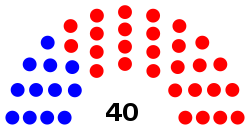Florida Senate | |
|---|---|
| Florida Legislature | |
 | |
| Type | |
| Type | |
Term limits | 2 terms (8 years) [a] |
| History | |
| Founded | May 26, 1845 |
| Preceded by | Legislative Council of the Territory of Florida |
New session started | November 19, 2024 |
| Leadership | |
President pro tempore | |
Minority Leader | |
| Structure | |
| Seats | 40 |
Political groups | Majority
Minority
Vacancies
|
Length of term | 4 years [a] |
| Authority | Article III, Constitution of Florida |
| Salary | $29,697.00/year + per diem (Subsistence & Travel) [1] |
| Elections | |
Last election | November 5, 2024 (20 seats) |
Next election | November 3, 2026 (20 seats) |
| Redistricting | Legislative control |
| Motto | |
| In God We Trust | |
| Meeting place | |
 | |
| Senate Chamber Florida Capitol Tallahassee, Florida | |
| Website | |
| The Florida Senate | |
| Constitution | |
| Constitution of Florida | |
| Rules | |
| The Florida Senate Rules | |
| Footnotes | |
 |
|---|
The Florida Senate is the upper house of the Florida Legislature, the state legislature of the U.S. state of Florida, the Florida House of Representatives being the lower house. Article III, Section 1 of the Constitution of Florida, adopted in 1968, defines the role of the Legislature and how it is to be constituted. [2] The Senate is composed of 40 members, each elected from a single-member district with a population of approximately 540,000 residents. The Senate Chamber is located in the State Capitol building.
Contents
- Terms
- Term limits
- Qualifications
- Legislative session
- Regular legislative session
- Special session
- Powers and process
- Leadership
- Composition
- Members, 2024–2026
- District map
- Past composition of the Senate
- See also
- Notes
- References
- External links
The Republicans hold a supermajority in the chamber with 26 seats; Democrats are in the minority with 10 seats. [3] One seat is held by an independent, and three seats are vacant.





